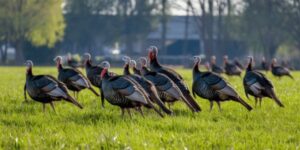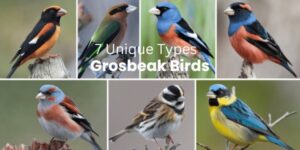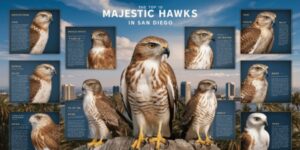Various geographical and ecological features mark Texas, and several different species of hawks can be found there. These beautiful raptors can be observed flying high in the sky, and their various types cater to different prey and environments. In this article, we will focus on 15 types of hawks that are commonly found in the Lone Star State.
1. Red-tailed Hawk (Buteo jamaicensis)
Identification and Characteristics
The Red-tailed Hawk, usually referred to as Buteo jamaicensis, is also known to be the large hawk, the most striking feature being the broad rounded wings and the semi-circle res tail, primarily pronounced in adults. The upper side is brown, and the lower underparts are generally pale with a band of streaked belly nations. They can have a wingspan of up to 1.5 meters, about 4.8 feet, while 18-26 inches long. Red-tailed Hawks make a very characteristic raspy scream that most movies portray when depicting birds of prey.

Habitat and Behavior
Red-tailed Hawks are generalists encountered in many places, such as grasslands, deserts, forests, and cities. They are also fond of sitting on the lookout on the pole or on the tree top, waiting for some small mammals, birds, and reptiles to prey on. They are monogamous and are usually faithful to their nesting site. They will each undertake circles while the other will perform a vertical dive.
2. Cooper’s Hawk (Accipiter cooperii)
Identification and Characteristics
The Cooper’s Hawk is a thickset hawk and measures neither less nor more than an averagely medium hawk with short wings and broad rounded tail, which habitually narrow out into the tip. The adult plumage is blue-grey above and red barred below and features a dark cap to the head. The young ones are streaked in brown and have brown underparts. They are 14-20 inches long, and the wing span is 24-35 inches.

Habitat and Behavior
Cooper’s hawks are primarily forest birds and are often seen hunting small birds in flight through the trees. They are gradually expanding into the suburbs and cities where bird feeders can quickly obtain food and locate prey, enhanced by rapid stealthy movement. They mate for life and seek out trees to build their stick nests.
3. Swainson’s Hawk (Buteo swainsoni)
Identification and Characteristics
The Swainson’s Hawk is a large, slender hawk with long wings and a short, rounded tail. Approximately half of the population is light morph with warm chestnut brown feathers in the head and the fore belly, with the remainder showing variable colours progressing to dark shades. Adults of this species may attain or measure 18 to 22 inches in length, with wings spanning between 46 to 54 inches.
You May Also Like: Top 10 Hawks in San Diego: (Majestic Birds of Prey)
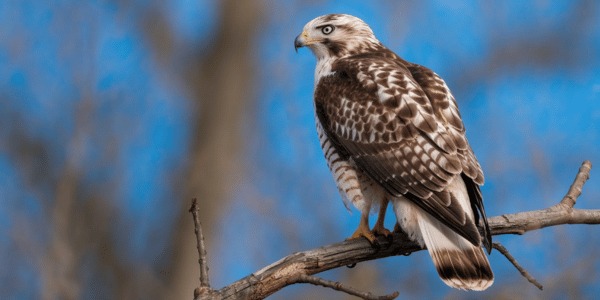
Habitat and Behavior
The Swainson’s Hawks are typically found in open country such as prairies, grasslands, and farmlands, searching for small mammals, bugs, and reptiles. They undertake some of the longest known migrations of any raptor, travelling once a year from north to south and covering about 12000 miles. The species seldom congregate but may do so in large numbers during times of migration. Basking in thermals has also been observed at high elevations.
4. Harris’s Hawk (Parabuteo unicinctus)
Identification and Characteristics
The Harris’s Hawk is a medium-sized dark brown hawk with chestnut on its wings, shoulders, and tail feather tips. Its length is about 18 to 23 inches, while its wingspan measures 40 to 47 inches.
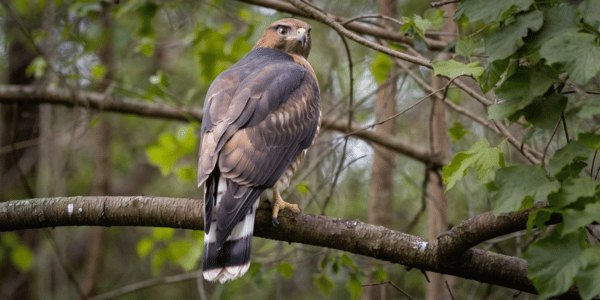
Habitat and Behavior:
Harris’s Hawks are distributed in primarily dry, open environments such as the desert or savanna regions, particularly in the southwestern region of the United States and Central and Southern America. Anderson et al. (1999). Unlike some raptors, this species is viewed as different due to its social organization: it hunts in groups. Working in teams enables it to hunt larger animals—for example, rabbits. It is no wonder that Harris’s hawks have also found great appeal among fanciers who hunt with birds of prey.
5. Northern Harrier (Circus hudsonius)
Identification and Characteristics:
The Northern Harrier, or the Marsh Hawk, is an aerodynamically shaped bird of prey that is intermediate in size with extended wings and a notable white rear end. The males are grey with a white underbelly, while the females are mottled brown with streaked underparts. They have an operculum – a membranous disk that resembles an eye and helps locate the target by sound. The length is about 18 – 20 inches, and the wingspan can measure 40 to 46 inches.
You May Also Like: The Truth About When Bald Eagles Achieve White Heads
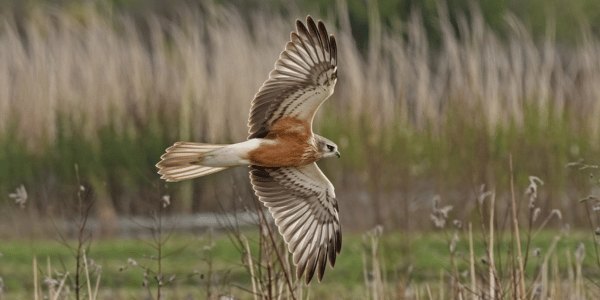
Habitat and Behavior
The Northern Harrier is usually found in wide-open spaces such as marshes, grasslands, and fields. Harriers strike and kill their prey, typically small mammals and birds, by flying at a low level utilizing their acute hearing and eyesight. Harriers are more of a loner and are hardly seen within clothed geographical boundaries due to their hunting characteristics. Harrier also appears to rank as The Commonest bald Eagle; among other differences, the females have distinct characteristics easily recognized by the colour that can be held feature in most.
6. Broad-winged Hawk (Buteo platypterus)
Identification and Characteristics
Broad-winged hawks are small-bodied fawn hawks with broad wings, a built tail, and stocky. The intermediate plumage is another swamp noctule, consisting of the brown upper parts and the underparts, which are whitish and crossed by horizontal brown-red bars. When soaring, they are around 13 to 17 inches in body length and 32 to 39 inches in wingspan.

Habitat and Behavior
All these birds make their home within deciduous forests in eastern America. Their migration is particularly well-known, with flocks of hawks gathering into massive groups called ‘kettles’, which can have thousands of birds in the fall as they head south to Central and South America. Broad-winged Hawks can also be found feeding on animals like reptiles and insects and, more often than not, on small mammals. They make their presence known well before their visual identification, which is possible by a sharp effusiveness that sounds sharp and of high frequency.
7. Ferruginous Hawk (Buteo regalia)
Identification and Characteristics
The Ferruginous Hawk is believed to be the fiercest species of hawk found in North America. It measures 22-27 inches and has a wingspan reaching 56 inches thick. Its massiveness, broad wings, pale colour, rusty brown of the upper tail and upper wings, and white underneath distinguishes it. The toes are covered with feathers, giving them a unique look.
You May Also Like: Small Southwestern Birds of Prey

Habitat and Behavior
Ferruginous Hawks are found in open areas, including plains, prairies, and deserts, in the western regions of the U.S. These birds inhabit open areas where they can feed on small animals such as prairie dogs or rabbits. Most of them can be seen U.S.ing on fence poles or in the air stationary, looking for their food. Generally, they prefer being alone, though two are often seen together during breeding season.
8. Sharp-shinned Hawk (Accipiter striatus)
Identification and Characteristics
The sharp-shinned hawk rank is the smallest-sized reigning hawk in NHawk America, measuring 9- 13 inches and having a wingspan of 17- 22 inches. Such hawks possess short, round-shaped wings and very long and narrow tails. Blue-gray on the back and orange on the barring at the back of the chest are the adults, browns, and the juveniles are the streaky breast bone brown.
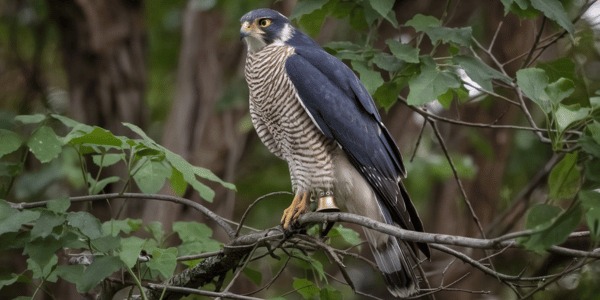
Habitat and Behavior
The range of sharp-shinned hawks includes prominent places closely spaced, usually trees and thickets, home to small bird species that are the primary source of their food. They can often be seen manoeuvring through the foliage to catch birds they can eat. They may be shy and seldom seen, except during migration, especially in clearings. They tend to be solitary and strongly include a potential territory, especially when mating.
9. Zone-tailed Hawk (Buteo albonotatus)
Identification and Characteristics
The Zone-tailed Hawk is a medium-sized raptor with a length of 17-22 inches and a wingspan of 42-55 inches. The zone-tailed hawk’s plHawk’sis is primarily dark with a sharp-winded tail and white wing stamping, typically fanned when soaring as when preying like a turkey vulture.
You May Also Like: 15 Stunning Birds With Mohawks
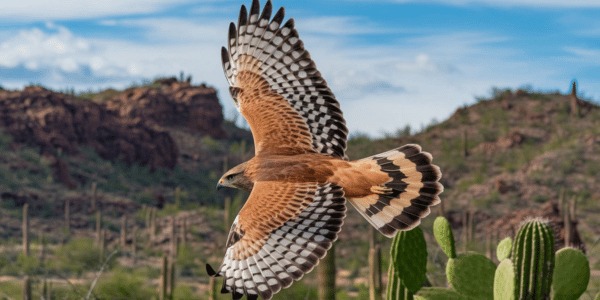
Habitat and Behavior
They inhabit zone-tailed hawks in arid and semi-arid regions, canyons, deserts, and mountainous regions. Their body shape, which effortlessly imitates the turkey vulture, is assumed to be a significant factor in their evolutionary adaptation and offers them the capability to strike at their prey without being detected. They catch and consume small mammals, birds, and reptiles, etc. These hawks will be almost always seen at cloud bases or up to high fliers using thermals.
10. Red-shouldered Hawk (Buteo lineatus)
Identification and Characteristics
The Red-shouldered Hawk is 15-20 inches with a wingspan of 37-43 inches. It is medium-sized in the raptors class. They are characteristically red-shoulder, barring on the underbody, and black and white checkered wing patterns. The adults have a distinctive loud “kee-ah” call.

Habitat and Behavior
These hawks are found in a woodland pattern mainly consisting of broad leaves but relatively close to water bodies. They ambush hunt for some small mammals, amphibians, and reptiles by sitting quietly, offering no movement or distraction. Red-shouldered Hawks are essentially territorial and defend their nesting sites aggressively. They can also court each other with graceful spirals high up over their territory owned by them.
11. Gray Hawk (Buteo plagiarism)
Identification and Characteristics
The gray hawk is known as Buteo. The range of the plant is 16-24 inches long with a wingspan of 35-39 inches, which is pretty small to moderate in the hawks, which have a body of qua slate grey colour and white-black conventional tail banding. The body colour is dark, while the flight feathers are light, thus contrasting with the body.
You May Also Like: 11 Red-Headed Birds of Hawaii
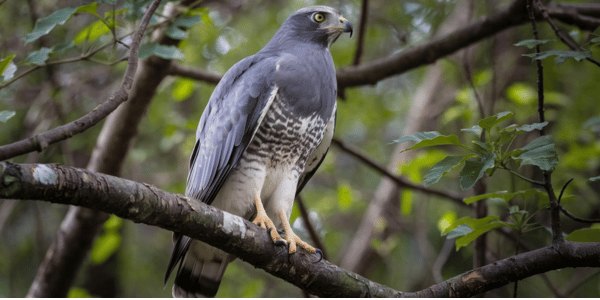
Habitat and Behavior
Gray Hawks are usually found in foundation rests and some open places close to the southwestern U.S. and Central American water. They are commonly seen resting quietly in the trees, hunting small animals, birds, or lizards. These hawks are very U.USS.gamous and are known to make high-pitched whistling noises, especially at the start of the breeding season.
12. White-tailed Hawk (Buteo Albicadatus)
Identification and Characteristics
The White-tailed Hawk is a large, slender hawk with ranges between 17-24 inches long and a wingspan of 46-56. The reason they call them this is that this species has. The tail feather, particularly the last, is whitish, with a black band on its outer shaft. Their body colour mainly includes pale grey upperparts, white lower parts with dark edgings, dark shoulders, and rufous on-the-shoulder regions in adults.
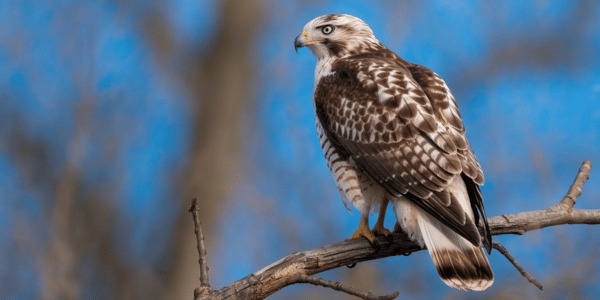
Habitat and Behavior
The southern United States, Central America, and parts of South America also have white, none-tailed hawks displaying their wings and only primarily to low but undulating beats as though perched in the open where they scan for their prey. White-tailed hawks include small mammals, birds, and friendly reptiles as part of their diet. Besides this, these hawks are quite famous for their unique courtship displays.
13. Rough-legged Hawk (Buteo lagopus)
Identification and Characteristics
Rough-legged Hawks are large-sized birds of hawks. They measure 18-24 inches in length and have a wingspan of 52-54 inches. Due to the avian plugging a human-wildlife conflict, they are long-haired. Some call exaggerated leads. This is Houghton Ho’s Ta-wing airplane. It bears a light brownish body with dark markings in the belly area and a well-bared tail with a tan-coloured marking.
You May Also Like: Can Birds Eat Popcorn?
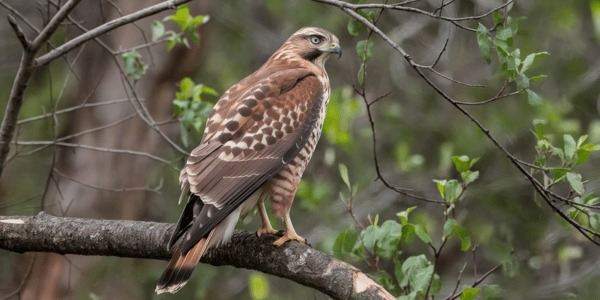
Habitat and Behaviour
These hawks breed in the Arctic tundra and migrate south to open fields, marshes, and prairies during winter. They suspend their bodies to hunt and search for small mammals like voles. Rough-legged Hawks are the only members of the raptor group who regularly hunt by performing standing chrysalis. They are seen as solitary individuals, although small flocks may occur during migration.
14. Common Black Hawk (Buteogallus anthracinus)
Identification and Characteristics
The Common Black Hawk is a meHawk-sized raptor but not so large. It measures approximately 17-24 inches, and its wings cape is approximately 44-51 inches long. It is almost entirely black and has a broad-winged and short tail with one broad white strip across it. Its legs are yellow, contrasting with its dark plumage.
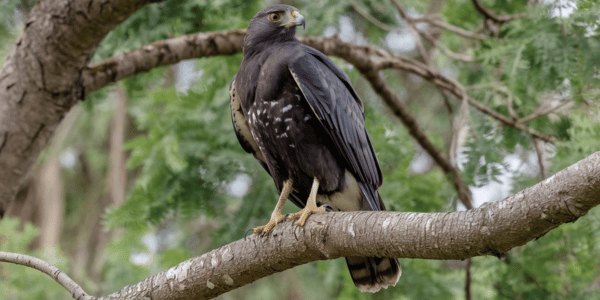
Habitat and Behavior
Common Black Hawks roost in riparian habitats like lake and river shores in North America, especially in the southwestern United States, Central America, and northern parts of South America. They mainly eat fish, frogs, and similar water animals. These hawks usually sit around water bodies at a low vantage point, ready to pounce on prey. They fly slowly with a lot of control and spend much time at a high elevation above their area.
15. Swainson’s Hawk (Buteo swainsoni)
Identification and Characteristics
Swainson’s hawk is one of the best-looking raptors. With a lengthened, slim body, it is a large hawk with long, hawking wings and a short-broad tail. They are more or less white below with a dark chest and have colour morphs that can be light, dark, or intermediate. Adults may attain about 460-550mm measurements with an average span of 60-70 inches.
You May Also Like: Beautiful Ducks You’ll Find in Spain
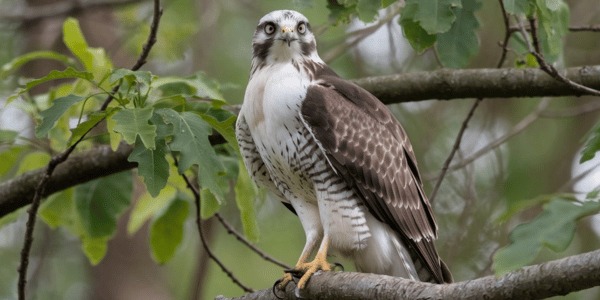
Habitat and Behavior
Swainson’s Hawks are fond of open lands, especially treeless prairies and grasslands or agriculture, where they forage small and small mammals, insects, or reptiles. One of the characteristics of Swainson’s hawks is that they make long migrations, their travel begins in North America and reaches south America every year, their distance is often up to around 12000 miles. Many times during their migration,, hawks aggregation can be observed, and during those thermals,, many of these even engage in soaring.
Conclusion
The variety of hawk species in Texas reflects the remarkable ecological diversity and landscape. For experienced or novice birdwatchers, the existence of these beautiful creatures in their environment is always pleasing. Every species is important in every ecosystem, such as balancing tiny bird population structures, controlling rats, etc. Through the knowledge and appreciation of these birds, it can be understood that there are active efforts to conserve the splendour and diversity that Texas has to offer.







